
Harrow and Hillingdon Geological Society
Yangshuo
Home | Monthly Meetings | Field Trips | Exhibitions | Other Activities | Members Pages | Useful Links
China – a geologist’s dream: the karst region of Yangshuo, China
Roger Lloyd
This presentation described a week’s holiday in Yangshuo, a city of about 300,000 people covering about half a square mile on the banks of the Li-Jiang River in Guanxi Province in China. Situated at 24 o47 ¢N, 110 o30 ¢E, Yangshuo has a seasonal monsoon climate with temperatures of 28+ oC in the hot season and 8 oC in winter. There are lots of karst mountains around the city.
The presentation covered the journey out and the time in Yangshuo, showed examples of local stones and building stones and explained how the karst mountains are formed. The route was via Muscat, where the regularity of erosional features in the wadis was noted from the air, Karachi, with the Indus delta and a giant salt pan visible from the air to Bangkok, then by South China Airlines to Guanzhou then Guilin.
The local building stone is either a marble or a limestone which takes a polish, often called marble in the building trade. Many of the blocks have uneven surfaces through the block with lines of mud/clay, probably deposited over bioclasts in a tidal area.
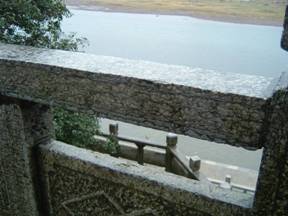
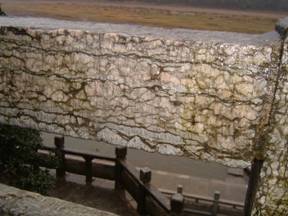
The common building stone in Yangshuo and in close-up
Karst covers large areas of the south of China, on carbonates which range from Devonian to the Triassic. Uplift of a huge thickness of limestone, at least 1,000m and probably more in some places, occurred about 20-40 million years ago. The carbonates between Guilin and Yangshuo are Devonian and Carboniferous.
The Chinese classify karst into two types:
- Fengcong – roughly conical hills separated by deep closed depressions all on a common bedrock base. With such continuous cover, vertical rock walls do not occur; and
- Fenglin – isolated hills rising from plains of limestone with a thin layer of alluvium, slope angles and individual profiles are immaterial. This is often called tower karst.
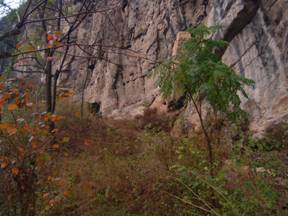
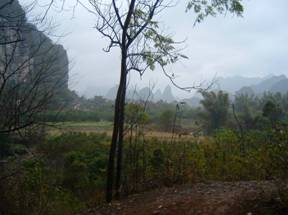
Vertical cliff face on tower karst The alluvial plain and tower karst
The spectacular karst mountains around Yangshuo comprise massively bedded limestone with a 5 o dip. There are lots of solution features and caves and some calcite and iron deposition. The immediate vicinity of Yangshuo comprises Fenglin karst but there is abundant Fengcong karst in the Li-Jiang valley northwards towards Guilin.


Tower karst in Yangshuo and across the Li-Jiang River
The evolution of the karst topography, as illustrated by Tony Waltham is:
- It starts with an initial surface on either an older plain or a landscape with inherited relief;
- Doline karst evolves as isolated depressions form around points of drainage into caves;
- Fengcong karst forms as dolines coalesce to remove any remnants of initial surface and residual hills become conical with dolines on all sides;
- Fengcong karst matures with continuing uplift as dolines deepen and smaller dolines are eliminated; the karst has maximum relief and is underlain by major cave systems;
- Base level is reached preventing further deepening of dolines and hills become smaller as surface dissolution continues; depressions widen by lateral planation with surface drainage on alluvium at base level in an early stage of Fenglin karst;
- Fenglin karst matures as conical hills develop into towers by undercutting; lateral planation is faster than surface lowering on the towers and allogenic clastic sediments maintain the alluvial plain;
- Slow tectonic uplift causes lowering of base level matched by dissolutional lowering of depression floors, which extend by lateral planation; towers erode more slowly so stand progressively higher above the renewed alleviated plain, forming the finest tower karst;
- Without upolift, lateral planation at a stable base level undercuts the towers, which become narrower and lower by repeated cliff collapse;
- Karst plain ultimately forms at base level by lateral planation.
Hard caps form through the reversible dissolution reaction Ca CO 3 + CO 2 + H 2O ↔Ca (HCO 3) 2 ,in which s light increases in temperature, decrease in vapour pressure of CO 2, or loss of water will cause the solution to lose CO 2; this breaks up the calcium bicarbonate and restores the relatively insoluble CaCO 3, which tends to be precipitated.
The presentation concluded with observations on the artificial rock features constructed alongside the Li-Jiang River, the variability of paving stones on South Street, Yangshuo, the distinctive weathering pattern of the limestones and the intensive agriculture on loess soils, virtually devoid of clay around Yangshuo.
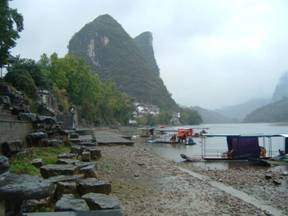
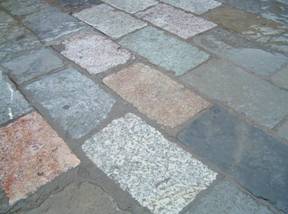
Artificial rock features on river bank Paving stones on South Street, Yangshuo